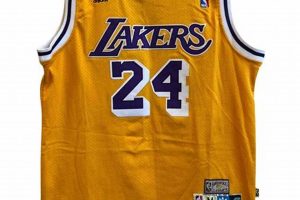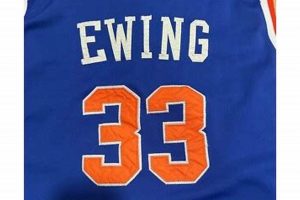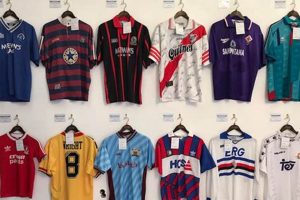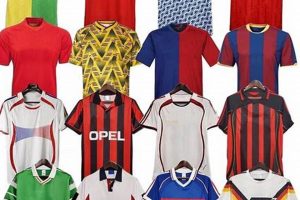Apparel representing hockey teams from previous eras holds significant value within the sports memorabilia market. These garments, often showcasing unique designs, materials, and team logos from bygone seasons, are coveted by collectors and enthusiasts alike. For example, a sweater worn by a celebrated player during a championship-winning year can command a substantial price.
The enduring appeal of such items stems from their tangible connection to hockey’s rich history. They provide a glimpse into the evolution of team branding, stylistic trends, and the cultural significance of the sport. Owning a piece of this history allows individuals to connect with past players, memorable games, and the broader narrative of the game. These pieces also often represent a limited production run, increasing their desirability.
The subsequent sections will delve into the various factors influencing the value of these historical athletic garments, examining elements such as condition, player association, team prestige, and the nuances of authentication within the collecting community. Considerations for proper storage and care will also be addressed.
Acquiring and Preserving Vintage Hockey Jerseys
The following guidelines provide essential information for those interested in acquiring, authenticating, and maintaining hockey apparel from past eras. Adherence to these recommendations can maximize the value and longevity of these historical items.
Tip 1: Research Thoroughly Before Purchase: Prior to acquiring a potential historical hockey garment, conduct extensive research regarding the specific team, era, and player associated with the item. Scrutinize available resources, including historical team archives, reputable collector guides, and auction records, to establish a baseline understanding of expected design, material composition, and market value.
Tip 2: Examine Construction and Materials: Authentic examples exhibit construction techniques and materials consistent with the period in which they were manufactured. Inconsistencies in stitching patterns, fabric type, or logo application may indicate a reproduction or alteration. For instance, observe the weave of the fabric or the style of the name and number stitching compared to known authentic examples.
Tip 3: Verify Team and Player Authenticity: Confirm the veracity of team logos, player names, and numbers. Cross-reference the presented information with reliable historical records to ensure accuracy. Discrepancies in font styles, color palettes, or number placement may suggest inauthenticity. Consider documentation proving player use, like photographs or letters of authenticity.
Tip 4: Assess Condition Carefully: Evaluate the overall condition of the garment, noting any signs of wear, damage, or repair. Examine areas prone to stress, such as seams, cuffs, and collar, for evidence of deterioration. Significant flaws may detract from the item’s value, although moderate wear can sometimes enhance its historical appeal.
Tip 5: Investigate Provenance: Acquire as much information as possible regarding the item’s provenance. Trace its ownership history back to its original source, if feasible. Documentation such as sales receipts, letters of authenticity, or photographs showing the item in use can significantly enhance its credibility and value.
Tip 6: Store Appropriately to Prevent Degradation: Implement appropriate storage practices to minimize the risk of damage. Avoid direct sunlight, excessive humidity, and extreme temperatures. Consider using acid-free storage materials to prevent discoloration and degradation of the fabric over time.
These guidelines offer a starting point for those seeking to engage with the world of historical hockey apparel. Diligent research, careful inspection, and informed decision-making are essential for successful acquisition and preservation.
The next section will discuss the long-term care and preservation strategies for these valuable historical artifacts, ensuring their continued appreciation by future generations.
1. Era Authenticity
Era authenticity is a cornerstone in the valuation and appreciation of historical hockey apparel. It signifies the degree to which a garment accurately reflects the manufacturing techniques, design elements, and material composition characteristic of its purported period of origin. The presence of anachronistic features, such as the utilization of synthetic fabrics in a jersey claimed to be from the pre-synthetic era, directly undermines its authenticity and market value. The accurate determination of era authenticity involves meticulous comparison against documented historical examples and reference materials.
Consider the example of a 1970s-era sweater claimed to have been worn by a prominent player. Verifying its era authenticity requires detailed scrutiny of stitching patterns, logo application methods, and the composition of the fabric itself. If the garment features heat-pressed letteringa technique not prevalent until the 1980sits purported 1970s origin becomes questionable. Similarly, the presence of a modern tagging system inside of it, not common on examples from that era, immediately indicates that the item does not reflect the manufacturing standards from the 1970’s era.
The implications of era authenticity extend beyond mere monetary value. It connects the collector or enthusiast to a specific moment in hockey history, reflecting the cultural and technological context of that time. Recognizing and verifying this authenticity requires specialized knowledge and careful attention to detail but is essential for responsible collecting and the preservation of hockey’s historical legacy. Failure to assess era authenticity can lead to misrepresentation, fraud, and ultimately, the erosion of trust within the collecting community.
2. Team Affiliation
Team affiliation is a critical determinant in the valuation and historical significance of apparel from prior hockey seasons. The specific team represented by a vintage jersey directly influences its collectibility and market desirability. The prestige and historical success of a team correlate positively with the value of its associated memorabilia. A jersey affiliated with a team boasting multiple championships or iconic players will generally command a higher price than one from a less prominent franchise. For example, a Montreal Canadiens sweater from their dynastic era in the 1970s holds considerably more value than a jersey from a team with limited historical success during the same period.
The impact of team affiliation extends beyond mere historical success. The location and cultural significance of a team within its community can also play a crucial role. Franchises with strong regional fan bases or a history of contributing to local identity often see heightened demand for their memorabilia. Furthermore, unique team branding or distinctive jersey designs can enhance their appeal. A rare or visually striking sweater from a team with a dedicated following is more likely to attract collectors and command a premium price. Consider, for instance, the original Winnipeg Jets sweaters featuring the distinctive circular logo; these are highly sought after due to the team’s historical importance and the jersey’s memorable design.
Understanding the connection between team affiliation and the value of vintage hockey jerseys is paramount for both collectors and historians. It provides a framework for assessing the historical importance and market desirability of these items. Recognizing the factors that contribute to a team’s prestige and cultural significance enables informed decisions regarding acquisition, preservation, and authentication. Ultimately, the appreciation of team affiliation deepens the understanding of hockey’s rich history and its enduring connection to communities and fans.
3. Player Association
The connection between a player and a vintage hockey jersey constitutes a significant factor influencing its value and collectibility. A jersey’s association with a notable player, particularly one with a distinguished career or memorable achievements, elevates its desirability among collectors. The following facets explore the nuances of this relationship.
- Iconic Player Endorsement
A jersey donned by a legendary player, such as Gordie Howe or Wayne Gretzky, immediately escalates in value. Their on-ice accomplishments, coupled with their cultural impact, transform the jersey into a tangible representation of hockey history. The presence of a signature or documented game usage further amplifies its worth.
- Statistical Significance
Sweaters worn during record-breaking seasons or landmark games hold heightened appeal. For instance, a jersey worn during a player’s 50-goal season carries more significance than one from a less productive year. Documentation verifying the jersey’s use during these key moments is crucial for substantiating its value.
- Rookie Season Impact
Rookie-year apparel associated with players who achieved early success or garnered significant attention often becomes highly sought after. These represent the nascent stages of a player’s career and the potential they exhibited from the outset. The scarcity of these items contributes to their increased value.
- Game-Worn Authentication
A jersey’s proven use in an official game setting is paramount. Game-worn jerseys, authenticated through photo-matching or team documentation, command substantial premiums over replica or unused examples. The tangible link to on-ice action distinguishes them from other jerseys and solidifies their historical significance.
In summation, the player association amplifies the intrinsic value of vintage hockey jerseys, transforming them into coveted artifacts of hockey history. Collectors prioritize jerseys linked to prominent players, significant statistical achievements, impactful rookie seasons, and, most importantly, verified game usage. The convergence of these factors dictates the desirability and market value of these historical garments.
4. Material Composition
The material composition of apparel from hockey’s past is a fundamental aspect determining its authenticity, condition, and ultimately, its value. The specific materials employed in the manufacturing process serve as a key indicator of the garment’s era of origin. For instance, early 20th-century sweaters were primarily constructed from heavy wool, reflecting the limited availability of synthetic fibers at the time. Progressing through the mid-century, blends incorporating cotton became more prevalent, offering enhanced comfort and breathability. The widespread adoption of polyester and other synthetic materials in the late 20th century dramatically altered the characteristics of hockey jerseys, impacting their weight, durability, and moisture-wicking capabilities. Therefore, an understanding of historical textile production is crucial for evaluating the legitimacy of a vintage specimen. A claimed pre-1950s sweater exhibiting synthetic fibers would be immediately suspect, revealing a likely modern reproduction or alteration.
Material composition also profoundly influences the long-term preservation of these historical items. Natural fibers like wool and cotton are susceptible to degradation from pests, moisture, and light, requiring specialized storage and cleaning protocols to prevent irreversible damage. Synthetic materials, while generally more resistant to these environmental factors, can still deteriorate over time, particularly through exposure to ultraviolet radiation or excessive heat. For example, improper washing or storage of a vintage polyester jersey can lead to discoloration, shrinkage, or even fiber breakdown, significantly diminishing its aesthetic appeal and market value. The appropriate care for each type of material is critical to prolonging the lifespan of the historical hockey garment.
In conclusion, material composition is not merely a superficial characteristic but rather an intrinsic element defining the authenticity, preservation requirements, and historical context of hockey apparel from past eras. Discerning the precise materials used in a vintage item is paramount for accurate dating, appropriate care, and informed valuation. Recognizing the interplay between material composition and historical manufacturing practices allows collectors and enthusiasts to appreciate the evolution of hockey apparel and safeguard these tangible links to the sport’s heritage. Without a comprehensive understanding of this element, true appreciation of the vintage hockey jersey and it’s potential historical importance cannot truly be realized.
5. Condition Assessment
Condition assessment is a pivotal aspect in determining the value and historical integrity of vintage hockey jerseys. The physical state of these garments directly reflects their provenance, storage history, and the extent of their usage. Deterioration stemming from wear, improper storage, or pest damage can significantly diminish a jersey’s value and authenticity. Therefore, a rigorous examination of the item’s condition is essential prior to acquisition or appraisal.
The relationship between condition and value manifests in several ways. For instance, a game-worn jersey from the 1970s, bearing visible repairs and staining consistent with its use on the ice, may still command a higher price than a pristine, unworn replica. The observable wear provides tangible evidence of its historical context and connects it to a specific player or event. However, excessive damage, such as large tears, significant fading, or widespread moth damage, invariably decreases its value. Moreover, alterations, such as replaced buttons or modifications to the logo, negatively impact authenticity and reduce collectibility. Consider, for example, a jersey from the early days of the NHL, crafted from delicate wool, exhibiting only minor wear along the seams. Such an item, despite its age, would be significantly more valuable than a similar jersey with extensive moth damage or crude repairs.
Accurate condition assessment necessitates a trained eye and familiarity with the materials and construction techniques employed in hockey jerseys throughout different eras. It involves scrutinizing the fabric for wear, discoloration, and damage; examining the stitching for repairs or alterations; and evaluating the integrity of the logos and lettering. Moreover, it requires understanding the distinction between acceptable wear consistent with age and use, and damage resulting from neglect or improper care. Ultimately, careful condition assessment is crucial for ensuring that the true historical and monetary worth of a vintage hockey jersey is accurately determined and that appropriate preservation measures are implemented.
6. Rarity Quantification
The scarcity of a specific example significantly influences the valuation of apparel from past hockey seasons. Rarity quantification involves assessing several factors that contribute to the limited availability of an item, thereby driving up its desirability among collectors. These factors include, but are not limited to, the production volume of a particular style, the duration of its usage, and the number of surviving examples in reasonably preserved condition. For instance, a jersey worn only during a single season due to a team rebranding or a short-lived commemorative event will inherently be rarer than one worn for multiple years. Similarly, a player-specific design produced in limited quantities for a promotional giveaway or special event will likely command a higher price due to its restricted availability. Careful analysis of these factors is crucial in establishing an accurate assessment of scarcity.
Practical application of rarity quantification requires the examination of historical records, team archives, and auction results. For example, if team records indicate that only 50 examples of a particular style of jersey were ever produced, this information provides a concrete basis for establishing its relative scarcity. Furthermore, comparing auction prices for similar items can provide insights into how the market values different levels of rarity. Consider the instance of a pre-war Montreal Maroons sweater; due to the team’s relatively short existence and the age of the garment, surviving examples are exceedingly rare, and their market value reflects this scarcity. Understanding this relationship allows collectors to make informed decisions about acquisitions and ensures that prices align with the actual availability of the item.
In conclusion, scarcity quantification is a critical component in determining the value and desirability of athletic apparel from former hockey seasons. Through careful analysis of production numbers, usage duration, and survival rates, a reasonable assessment of rarity can be achieved. This understanding allows collectors to make informed decisions, ensures accurate appraisals, and contributes to the overall appreciation of hockey’s historical legacy. However, the subjective nature of collectibility and the fluctuating demands of the market present ongoing challenges to precise rarity quantification. The intersection of objective data and subjective collector preferences ultimately shapes the perceived value of hockey apparel.
7. Provenance Documentation
Provenance documentation serves as a critical component in establishing the authenticity and value of hockey garments from previous eras. This documentation, encompassing a historical record of ownership and contextual details, directly impacts the perceived worth and collectibility of these items. Without verifiable provenance, the authenticity of a vintage sweater remains questionable, significantly diminishing its market desirability. The presence of comprehensive documentation mitigates the risk of acquiring a replica or altered item, offering assurance to collectors and historians alike. This documentation also provides important context to the Jersey and it’s history.
Examples of impactful provenance documentation include letters of authenticity from team historians, photographs depicting the jersey in use during a specific game, or sales receipts tracing the item’s ownership back to the original player or their family. Consider a hypothetical 1960s Toronto Maple Leafs sweater attributed to a prominent player; its value would be substantially increased by the existence of a letter from the Hockey Hall of Fame confirming its authenticity and game usage. Conversely, the absence of any supporting documentation would render the sweater’s claim unverifiable, potentially reducing its value to that of a mere replica, despite outward appearances. In fact, many jerseys are almost worthless without documentation.
In conclusion, the presence of robust provenance documentation is indispensable for discerning the true worth and historical significance of vintage hockey garments. It functions as a safeguard against fraud, bolsters collector confidence, and allows for a more complete understanding of the item’s place within the broader narrative of the sport. The challenges of acquiring complete and verifiable documentation underscore the importance of diligent research and authentication efforts within the collecting community. It ultimately determines an item’s value for insurance, legacy, and peace of mind.
Frequently Asked Questions
The following section addresses common inquiries regarding athletic garments from prior hockey seasons, providing clarity on pertinent aspects of authenticity, valuation, and preservation.
Question 1: How can one differentiate between a legitimate vintage hockey jersey and a reproduction?
Distinguishing between an authentic historical hockey garment and a modern reproduction necessitates careful examination of manufacturing techniques, materials employed, and design details consistent with the era of origin. Scrutinize stitching patterns, fabric composition, and logo application methods against documented historical examples. Consult reputable collector guides and authentication services for expert verification.
Question 2: What factors primarily influence the valuation of hockey apparel from past eras?
Valuation is determined by a combination of factors, including the jersey’s age, team affiliation, player association, condition, rarity, and provenance documentation. Garments associated with iconic players, championship-winning teams, or unique historical events command higher prices. The presence of verifiable documentation further enhances value.
Question 3: What constitutes acceptable wear and tear versus damage that significantly reduces the value?
Acceptable wear includes minor fading, slight discoloration, and small repairs consistent with age and usage. Significant damage, such as large tears, extensive staining, or pervasive moth damage, substantially diminishes value. Alterations, such as replaced buttons or modified logos, also negatively impact collectibility.
Question 4: What are the recommended storage practices for preserving hockey jerseys from previous decades?
Proper storage entails avoiding direct sunlight, excessive humidity, and extreme temperatures. Employ acid-free storage materials to prevent discoloration and degradation of the fabric over time. Consider professional conservation services for delicate or highly valuable garments. Avoid storing in areas where pests may be present.
Question 5: How important is it to authenticate a sweater from a past hockey season before purchasing it?
Authentication is paramount. It mitigates the risk of acquiring a counterfeit or misrepresented item. Seek opinions from reputable authentication services or consult with experienced collectors. Documentation from team historians or the Hockey Hall of Fame further substantiates authenticity.
Question 6: Where can one reliably acquire historical hockey apparel?
Reliable sources include reputable auction houses specializing in sports memorabilia, established vintage sporting goods dealers, and private collectors with verifiable references. Exercise caution when purchasing from online marketplaces and prioritize vendors with transparent return policies and authentication guarantees.
In summary, meticulous research, careful inspection, and informed decision-making are crucial for successful acquisition, preservation, and appreciation of historical hockey apparel. Consulting with experts and prioritizing verifiable documentation enhances the likelihood of acquiring authentic and valuable items.
The following section will explore the enduring appeal and cultural significance of vintage hockey jerseys within the broader context of sports memorabilia and historical preservation.
Conclusion
This exploration has illuminated the multifaceted nature of vintage hockey jerseys, underscoring their significance as tangible artifacts of sports history. The factors influencing their value, from era authenticity and team affiliation to player association, material composition, condition, rarity, and provenance, require careful consideration. The acquisition, preservation, and authentication of these garments represent a commitment to safeguarding a vital aspect of hockey’s cultural heritage.
The study of vintage hockey jerseys extends beyond mere collecting. It serves as a conduit for understanding the evolution of the sport, its impact on communities, and the enduring appeal of its iconic figures. Continued research, diligent preservation efforts, and ethical collecting practices are essential to ensure that these historical garments remain accessible to future generations, providing them with a direct connection to the rich history of hockey. Preservation and thoughtful collecting will ensure that this history will endure.







